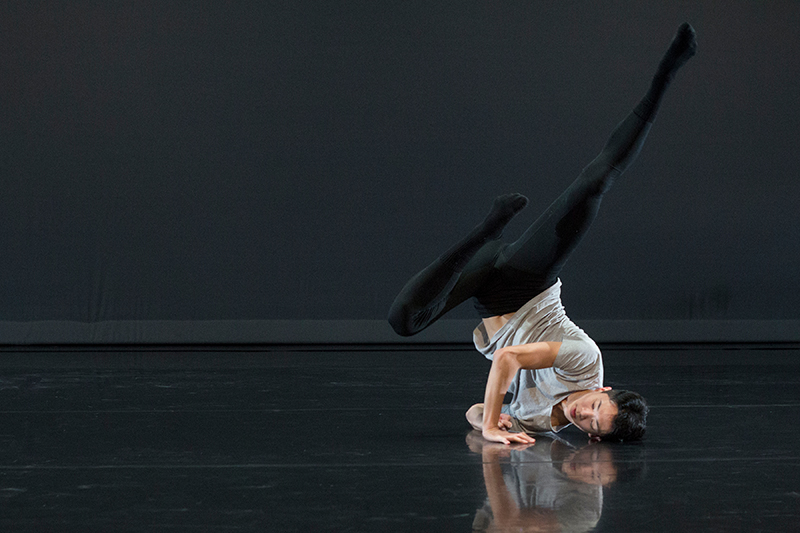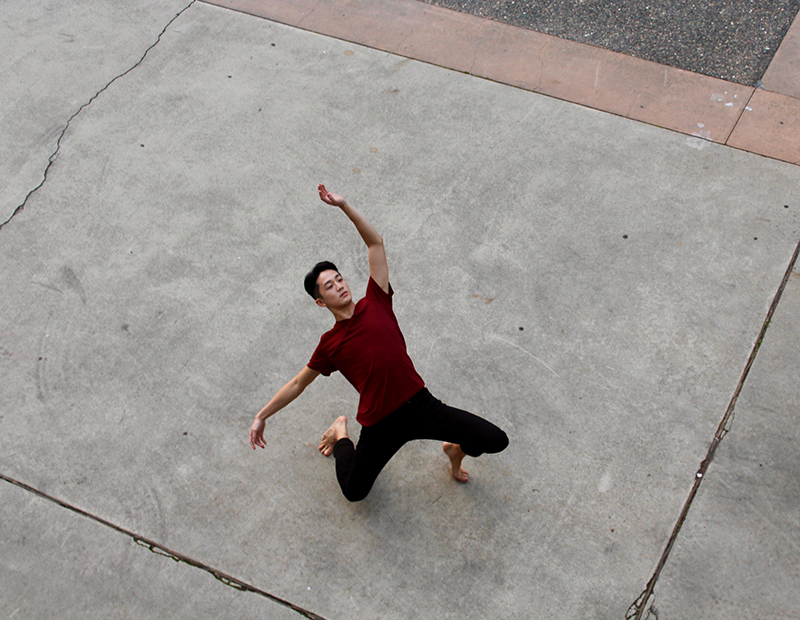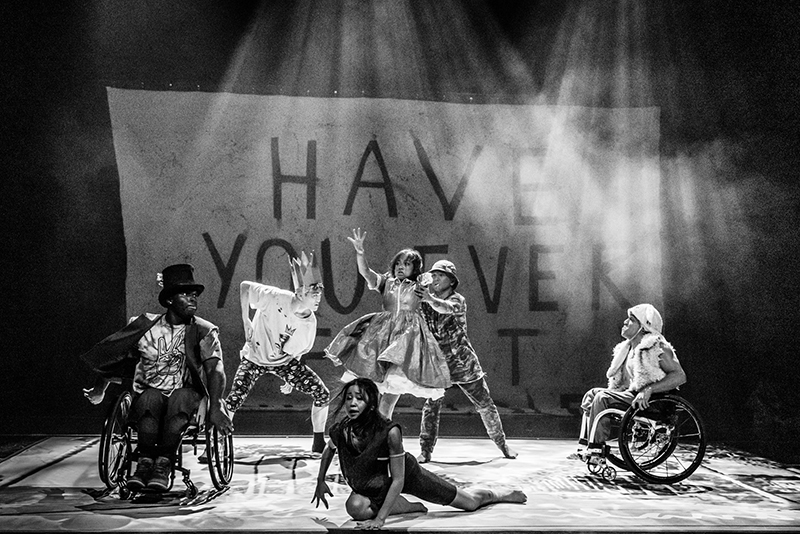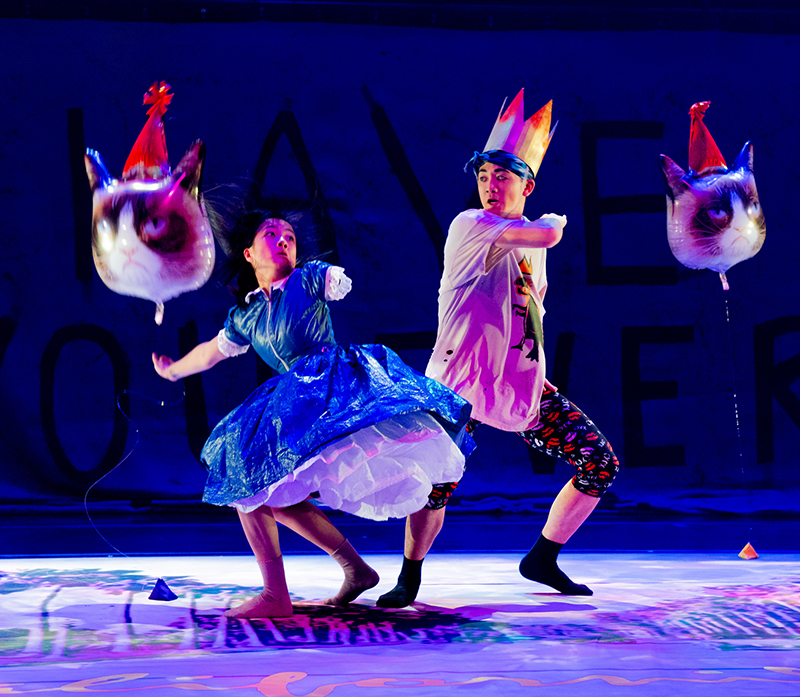Thinking about Western Dance Culture
November 16, 2020
An Interview with Bradford Chin
BY EMMALY WIEDERHOLT
Bradford Chin is a dance educator, choreographer, performer, and researcher based in San Francisco, CA, and a dancer and teacher with AXIS Dance Company, a physically integrated dance company in Oakland, CA. Here, he discusses his interest in dissecting mainstream Western dance culture across scholarship, pedagogy, and performance.

Photo by Pat Berrett; Image Description: Bradford balances upside down on a glossy, reflective black marley floor. He is perched on one shoulder, his other hand, and the side of his head with his legs forming two parallel lines above him, one bent sharply at the knee, and the other extending straight up. He is wearing a light grey t-shirt, black tights, and black socks.
~~
Can you tell me a little about your dance history – what shaped who you are today?
My name is Bradford, and I use he/him/his pronouns. I am a San Francisco native, which is becoming increasingly rare and comes with its own privileges. I did not take my first ballet or modern classes until I was a freshman in college at Cal State Long Beach. I started as a pre-med biology major. I was introduced to and encouraged to dance at the end of high school by Nina Mayer, but as far as what people would consider “formal training” in Western dance culture, it wasn’t until college. Somehow, I got into the program when I auditioned to minor, which happened to be the same audition to major, and then I switched.
I had a very conservative Christian upbringing coupled with my experience as an Asian American. Undergrad, for me, was a lot of struggle, both internally and externally. I was trying to navigate my sexuality without having role models or support. Doing that alone, along with not having familial support on my new dance journey, was really hard. But it also felt like the right path, and those experiences informed my interest in the minoritized student experience in Western dance culture. I didn’t have the vocabulary to iterate or understand the questions I was dealing with at the time. It’s only after I’ve graduated and continued with this line of work that I’ve been able to contextualize it.
As a freelance choreographer, my questioning revolves around Western dance performance practices, conventions of Western dance theater, why we do the funny things we do, what is it about the choreographer/dancer/audience relationship, etc. Unpacking that led me into questioning how educational practices in dance continue to perpetuate those practices in performance.
I have had the privilege of working with marginalized student populations, like students from very low-income households, people of color, and people with disabilities, which has significantly impacted my pedagogy and how I consider equity in dance. I’m currently a dancer and teaching artist with AXIS Dance Company, a physically integrated dance company which is one of the world’s leaders in inclusive dance education. Physically integrated means we have dancers with and without physical disabilities.
All these experiences continue to build on my questioning of Western dance practices, and now I’m going into the next iteration of these research interests: How does inequality impact the aesthetics of Western concert dance?
What does your current practice look like, especially in light of the pandemic?
With the pandemic, I’ve been in a fortunate position. To a certain degree, I’ve been thriving. My partner and I became long distance when I started with AXIS last year and moved back to the Bay Area. He’s currently a doctoral student at UC Irvine in Southern California. He was visiting San Francisco for his birthday weekend when lockdown started, and we’ve been sheltering in place together since. It’s been a huge boon for my mental health. Practice wise, it’s been a huge advantage to not be commuting an hour and a half each way for rehearsal every day.
To a certain extent, how I introduce myself as an artist hasn’t changed. I still introduce myself as an educator, choreographer, performer, and researcher. Especially with the additional time I’ve gained since the pandemic began, I’ve been able to dive into my own scholarship. I’ve begun translating my applied research into theory. I’m about to send off a publication for review, and I’ve already begun working on a second publication based on my work with AXIS and ballet pedagogy. Overall, the pandemic has allowed me to expand my practice.

Photo by Kayling Bourdon; Image description: Bradford balances on the balls of his feet and hinges backward. He looks up toward the right side of the frame while extending one arm loosely next to his face and the other behind him toward the ground. Barefooted, he is wearing black jeans and a maroon v-neck t-shirt and is standing on grey concrete with a light greyish pink accent border.
Since joining AXIS last year, how has your perspective on disability in dance evolved?
My first experience with dance and disability was in January 2018 during a guest residency at Keshet Dance and Center for the Arts in Albuquerque. I was creating a new work with Keshet’s community dancers, people local to Albuquerque. One of the dancers had cerebral palsy. I was anxious going into the process because I had never worked with a physically integrated cast. My experiences as an educator leading up to that informed my process, as well as the lessons from my mentors who had emphasized equitable collaborations. The focus on asking questions and inviting people into a process made it so that I actually felt at home. Something clicked: This is what I’m supposed to be doing. Up to then, I had almost reached a burning out point.
Since then, as an educator especially, I’ve grown so much. My conceptions of technique and aesthetics in Western dance culture have expanded. A core of AXIS’ work is the principle of movement translation. We move beyond what a movement is supposed to look like and dive into the intention of the movement in order to find movement across all bodies. My work with AXIS has pushed me into questioning what kinds of works we want to see, what works we allow to be created, and what works we deem “excellent and presentable.” What is it that makes one work good as opposed to another work?
Can you share a little bit about your own choreographic practice? I understand you had a project-based company in Los Angeles before moving back to the Bay Area. What are you working on/interested in now?
The last two works I presented were in 2019, and they overlapped my joining AXIS. After that, I decided to hold off a little bit, as I had spent the past several years hustling. I wanted to settle into the company dynamic and figure out where in my new dance community I fit in. In moving back home to San Francisco, I also needed to learn how my relationships and obligations to my family had changed in the seven years I lived in Southern California. I have a lot of close family on both sides in the Bay Area. I had just started to feel like it was time to begin branching out and finding my artistic voice again when the pandemic hit. With that newfound time, I’ve been writing and figuring out how to communicate my choreographic practice and values.
I’m not funny or quick-witted, but my choreographic practice has been my way of being funny even if I’m not. I created a series of works that look at the choreographic process, like a meta presentation where the audience observes a rehearsal process as it’s happening. I use comedic devices like hyperbole, comedic timing, and clowning to amp what you might witness in a rehearsal. Iterating that for an audience makes it funny because it’s these truths we all know happen, but no one really talks about them. The series of works looks at artistic license and what we as audience members and dance makers think is good presentable work, and then I flip that narrative on its head and make fun of what we do while also pointing at the oppressive practices we enact as well.
Can you share more about the research you’ve been working on?
The first publication I’m about to send off for review. The idea for it came up this past summer in response to an article I read about the #boysdancetoo movement of last year. My partner is working toward his PhD in sociology. He specializes in looking at gender, sexuality, and masculinity. We talk a lot about social justice, bouncing around ideas, which informs my research. I read this article by Luke Muscat called “The Weight of Words: A Message to Dance Educators, Caregivers, and Society.” It was about trying to do away with the gendering of dance technique. I’m very on board with trying to de-gender dance education practices, especially when it comes to the gender binary. But a core part that a lot of people missed with #boysdancetoo was that while men do experience difficulties in coming to dance, and specifically ballet, equating boys or men to femininity and womanhood is actually a subordination of women. By reinforcing the idea that men should break out of stereotypes by separating themselves from women, we’re also reinforcing the concept of womanhood as an insult to masculinity and pushing women to a lower level than men.
I used Dance Data Project’s work to look at ballet culture in the US. There are a lot of women in ballet companies, especially compared to men. But when you look at artistic directors and what choreographers are being presented, it totally skews in the opposite direction. Combing through companies’ dancers, I found that women made up more than half of the lower levels of companies. The corps was 55 to 60 percent women, and in trainee programs and apprenticeships, women made up 80 percent. But at the leadership level, women make up a quarter of directors and even less of resident and commissioned choreographers. A lot of practices need to be questioned in ballet culture. It’s also societal expectations like motherhood and family. We’re seeing this now in the pandemic where overwhelmingly it’s women who are leaving the workforce because they are the ones who are taking care of their families.
Despite the arguments of #boysdancetoo, it’s actually the women in ballet who face greater hardships internally. The hardships men experience in pursuing ballet come externally from outside dance. Obviously, this is looking at a gender binary. If someone wants to take this research forward, one of the ways to continue would be looking beyond the gender binary.
My newest research looks at using nontraditional music in ballet as a way of expanding the narrative of who can experience or enjoy ballet. By nontraditional, I mean non-classical music, or not traditional to the ballet canon. During this pandemic, AXIS has been holding classes online and people all over the world have been joining in. Because of what AXIS is, we have seen a lot of people who have not traditionally been able to access Western ballet offerings. Classical music comes from a narrative of whiteness, Eurocentrism, and colonization, and it still plays a part in excluding people from personhood even today. In that context, I’ve been looking at the application of nontraditional music as a form of decolonialization. My interest is driven by culturally relevant pedagogy and critical pedagogy, coined by Gloria Ladson-Billings and Paulo Freire respectively. A key principle of both is looking at students not as empty vessels that need to be filled, but as collaborators who inform the learning process with their different experiences.

Photo by Steve Disenhof; Image description: Six AXIS Dance Company members are in various states of vicious confusion and chaos, some by themselves and some toward each other. They are costumed as homeless versions of characters from Lewis Carroll’s Alice’s Adventures in Wonderland (from L to R): The Mad Hatter, The Queen of Hearts, the “real life” homeless alter ego of Alice, Alice, The Caterpillar, and The White Rabbit.
For example, I taught a themed class where we only used music by living Black women, or another class where we exclusively used music by Hispanic and Latinx artists. For the class where we used music by living Black women, one of the white-presenting participants shared afterward that the music allowed them to find agency within the technique and how it manifests on their own body. The use of music is one tool to break down barriers of exclusion that people from marginalized communities might experience if and when they approach ballet.
I often wonder about how to teach dance techniques in ways that are accessible and share the intention behind the movement, while still honoring the history and codification of dance forms, whether that’s ballet, West African dance, classical Indian dance, hula, flamenco, etc. How do you navigate this in your own teaching practice?
I don’t know if I have any answers, but I can share some thoughts I struggle with. I know there are teachers who teach without the use of demonstration for any number of reasons. When I’m teaching, I demonstrate to help communicate the intended aesthetic, and I might be seated, standing, both, or neither. However, an issue is that my demonstration still centers a non-disabled body, even though I’m leaving the movement open for others to play with.
Then we can look at intention. Part of the intention of a tendu, for example, is pushing down through the base and finding energy to reach out while also reaching in. How do you play with the multiple directions of energy and the uprightness of the movement? In theory, all of these kinesthetic concepts can be applied to any movement practice, but how do you manifest each unique aesthetic? There are so many considerations.
Dance is a communal act. Something we emphasize at AXIS is that we teach with the people who are in the room. Like any teacher, you might get into a pattern of how to approach something to make it more inclusive, but you don’t know if it will work until you begin working with the people in the room. What is it that differentiates ballet from West African dance from Indian classical forms? I wonder if part of it is how the community defines and practices it. What also is aesthetic purity? How do you hold it, transmit it, but also allow it to grow?
How do you imagine your work growing in the future?
I started coming to this realization even before the pandemic that I’m reaching another juncture where there are several paths before me and I can very clearly envision myself pursuing any one of them – scholarship, performance or choreography – and I wonder why those different paths can’t be the same path. I understand that logistically speaking, I can’t do it all at once. I’m in the process of applying to graduate programs to research the politics of aesthetics in Western concert dance, and how inequality impacts those aesthetics. But I still have artistic and choreographic ideas I want to pursue too.
~~
To learn more, visit bradfordchindance.wixsite.com.

Photo by Steve Disenhof; Photo description: Bradford gets low and winds his elbow below his chin as if to strike Lani, a dancer with one arm, who is preemptively ducking to dodge the blow. Bradford is wearing black leggings with white and red kissy lips, an extra large and extra ragged white t-shirt with a dinosaur on it, and a cardboard crown. Lani is wearing a poofy dress made out of blue tarp. There is a “Grumpy Cat” balloon on each side of them.
